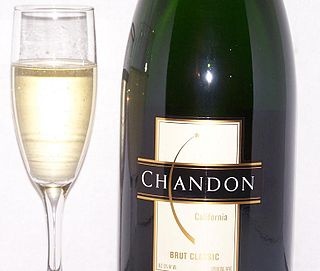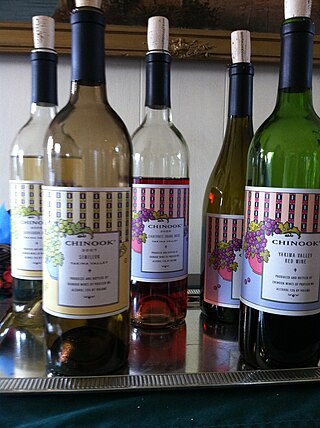Related Research Articles

Warren Winiarski was an American Napa Valley winemaker and the founder and proprietor of Stag's Leap Wine Cellars.

Ridge Vineyards is a California winery specializing in Cabernet Sauvignon, Zinfandel, and Chardonnay wines. Ridge produces wine at two winery locations in northern California. The original winery facilities are located at an elevation of 2,300 feet on Monte Bello Ridge in unincorporated Santa Clara County in the Santa Cruz Mountains AVA, south of Los Altos, California and west of Cupertino, California. The other Ridge winery facilities are at Lytton Springs in the Dry Creek Valley AVA of Sonoma County. Ridge Vineyard's 1971 Monte Bello Cabernet Sauvignon gained prominence for its fifth-place finish in the 1976 "Judgment of Paris" wine tasting.

Heitz Cellar is a California wine producer located within Napa Valley east of the town of St. Helena. An early modern era Napa Valley presence and pioneering exponent of French oak, the estate enjoys a historical renown with the success of its Martha's Vineyard Cabernet Sauvignon, and has also been described as a "master of Grignolino".

Paul Draper is a California winemaker who has been the chief winemaker at Ridge Vineyards in California since 1969. Without any formal training in winemaking, Draper first gained recognition for his 1971 Monte Bello Cabernet Sauvignon when it placed fifth at the Judgment of Paris wine tasting. Draper has played a significant role in the history of California wine through his pioneering work in popularizing "vineyard-designated" wines as well as instigating the resurgence of old vine Zinfandel. Along with Ravenswood Winery's Joel Peterson, Draper is considered one of the most important figures in the history of Californian Zinfandel, rescuing the grape from obscurity and demonstrating its full potential as a serious wine. Draper was featured in a short film titled Terroir and directed by Christopher McGilvray which was shown at the 2017 Cinequest Film Festival.

Domaine Chandon is a winery located in the town of Yountville, California, in the Napa Valley. Established in 1973 by Moët et Chandon, and led by businessman John Wright, who operated the company for over 20 years, it was the first French-owned sparkling wine producer in the Napa Valley.

J. Lohr Vineyards & Wines is a winemaking company headquartered in San Jose, California, with over 4,000 acres of estate vineyards in the Paso Robles AVA in San Luis Obispo County, Arroyo Seco and Santa Lucia Highlands AVAs in Monterey County, and the St. Helena AVA in Napa Valley, California. The family-owned and operated company was founded by Jerry Lohr in 1974. The company operates wineries in San Jose, Paso Robles, and Greenfield, California. In 2013, Steve Lohr was appointed CEO of the company. J. Lohr Vineyards & Wines’ product portfolio includes eight tiers of wine: J. Lohr Signature, J. Lohr Cuvée Series, J. Lohr Vineyard Series, J. Lohr Gesture, J. Lohr Pure Paso Proprietary Red Wine, J. Lohr Monterey Roots, J. Lohr Estates and ARIEL Vineyards. The portfolio also includes specialty brands Cypress Vineyards and Painter Bridge. J. Lohr ranks among the top 25 wine producers in the United States, with annual US sales exceeding 1.8 million cases.

Sonoma County wine is wine made in Sonoma County, California, in the United States.

California wine production has a rich viticulture history since 1680 when Spanish Jesuit missionaries planted Vitis vinifera vines native to the Mediterranean region in their established missions to produce wine for religious services. In the 1770s, Spanish missionaries continued the practice under the direction of the Father Junípero Serra who planted California's first vineyard at Mission San Juan Capistrano.

Friuli-Venezia Giulia wine is wine made in the northeastern Italian region of Friuli-Venezia Giulia. There are 11 denominazione di origine controllata (DOC) and 3 denominazione di origine controllata e garantita (DOCG) in the Friuli-Venezia Giulia area. The region has 3 indicazione geografica tipica (IGT) designations Alto Livenza, delle Venezie and Venezia Giulia. Nearly 62% of the wine produced in the region falls under a DOC designation. The area is known predominantly for its white wines, which are considered some of the best examples of Italian wine in that style. Along with the Veneto and Trentino-Alto Adige, the Friuli-Venezia Giulia forms the Tre Venezie wine region, which ranks with Tuscany and Piedmont as Italy's world class wine regions.

Quilceda Creek Winery is a boutique winery in Snohomish, Washington specializing in premium Cabernet Sauvignon wine. The winery is named for a nearby creek in Snohomish County. Although the winery facility is located west of the Cascade Range, the winery sources all of its grapes from its four estate vineyards in the Horse Heaven Hills AVA and Red Mountain AVA. Quilceda Creek Winery has earned some of the highest reviews and awards of any winery in the United States and was the first American wine from outside of California to earn a perfect 100-point score from wine critic Robert Parker's publication The Wine Advocate. Since its founding in 1978, Quilceda Creek has received an additional seven 100-point scores from Robert Parker's Wine Advocate, one 100-point score from Decanter (Magazine) and two 100-point scores from acclaimed wine blog OwenBargreen.com. In addition to critics' praise, one of the highest honors for Quilceda Creek happened when President Barack Obama chose to serve their 2005 Cabernet Sauvignon Columbia Valley at a White House dinner to President Hu Jintao of China in 2011.
Smith-Madrone Vineyards and Winery is a winery in Napa Valley in the Spring Mountain District AVA. It was founded in 1971 by Stuart Smith. The name Smith-Madrone comes from combining the founders' name with the madrone trees among the estate. The winery is a long-time pioneer of dry farming.
Ahlgren Vineyard was a vineyard and winery located in the Santa Cruz Mountains AVA, in Boulder Creek, California, United States. Founded in 1976 by Dexter and Valerie Ahlgren, they produced 2,500-3,000 cases a year until their closure in 2016. The winery was located in the cellar of the Ahlgren's home. Ahlgren Vineyard used hands on, traditional methods of winemaking to create wine varietals including Sémillon, Chardonnay, Cabernet Sauvignon, Merlot, Cabernet Franc, Zinfandel, Nebbiolo, Pinot noir, and Syrah. Their grapes came from the Santa Cruz Mountains, Livermoore Valley, and Monterey. In 2000 Dexter Ahlgren suffered from a stroke, and the couples daughter, Beth Ahlgren, took over as winemaker. Dexter recovered enough to allow him to take part in the winemaking process.

Chinook is a Washington winery located in the Yakima Valley AVA. Founded in 1983 by the wife and husband team of Kay Simon and Clay Mackey, Chinook was one of the pioneering wineries that established Prosser, Washington as a major wine-producing region in Washington state. Kay Simon, who began her career after graduating in 1976 from University of California-Davis in California's San Joaquin Valley and at Chateau Ste. Michelle, was one of the first female winemaker in Washington State. Chinook wines are widely regarded for their quality and help spread recognition for Washington wines. They are considered by wine experts such as Paul Gregutt to be "the classic expression of Yakima Valley fruit". Chinook's work with Cabernet franc, in particular, has garnered the statewide acclaim with the dry Cabernet franc rosé often described in wine reviews as a "Washington Chinon".
Cathy Corison is an American winemaker, entrepreneur and consultant. She specializes in Cabernet Sauvignon. Corison was the San Francisco Chronicle Winemaker of the Year in 2011.
Amy Aiken is an American entrepreneur and winemaker. She focuses on Cabernet Sauvignon wines and owns her own wine labels: Meander and Conspire.

Baldacci Family Vineyards is a family-owned winery located in the Stags Leap District AVA of Napa Valley. Established in 1998, Baldacci Family Vineyards owns over 50 acres of sustainably-farmed vines in three distinct Napa Valley appellations: Stags Leap District, Calistoga, and Los Carneros. The wine portfolio is focused on limited-production, estate-grown wines.

Kenwood Vineyards is a winery in Kenwood, California, located on Highway 12 in the Sonoma Valley wine country. It is currently owned by Pernod Ricard Winemakers.

Jean-Charles Boisset is a French vintner and the proprietor of the Boisset Collection, which operates 28 wineries in California, France, and Canada.

Anthony "Tony" Douglas Jordan was an Australian winemaker and oenologist.
References
- ↑ Howard G. Goldberg (February 18, 1987). Wine Talk The New York Times . Accessed 2007-12-05.
- ↑ Sexton, Jean Deitz. Wines & Vine, December 1995. Retrieved October 2007. http://findarticles.com/p/articles/mi_m3488/is_n12_v76/ai_17843513.
- ↑ Kramer, Matt. Matt Kramer’s New California Wine: Making Sense of the Napa Valley, Sonoma, Central Coast and Beyond. (Philadelphia and London: Running Press, 2004), 126. ISBN 0-7624-1964-4
- ↑ Spurrier, Steven, Decanter. (September 2007). "Joining the Top Table" p.13.
- ↑ Taber, George. Judgment of Paris: California vs. France and the Historic 1976 Paris Tasting. (New York: Simon & Schuster, 2006), ISBN 1-4165-4789-4
- ↑ David Stoneberg (May 24, 2007). Napa now on EU map. NapaValleyRegister. Accessed 2007-12-07.